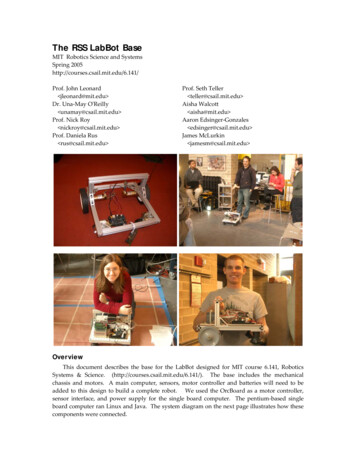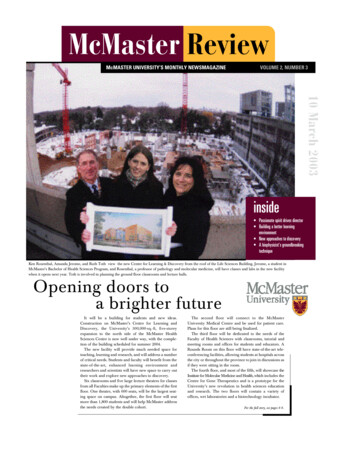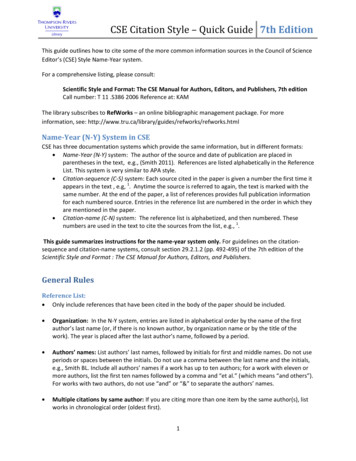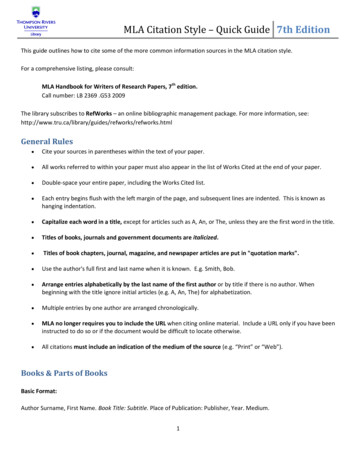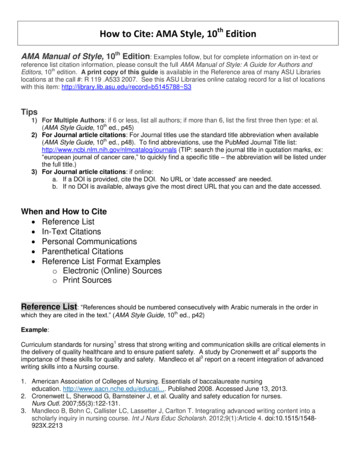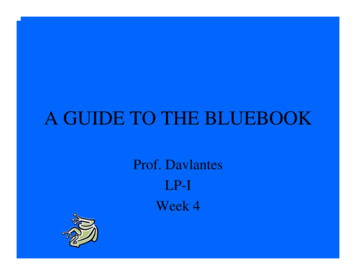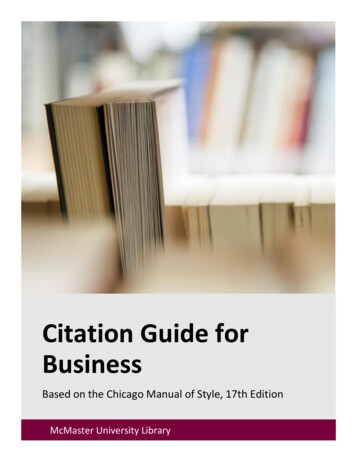
Transcription
Citation Guide forBusinessBased on the Chicago Manual of Style, 17th EditionMcMaster University Library
Contents0Part One: IntroductionCitation Style . 1Order of Elements in Paper . 1Headings and Subheadings . 2Page Numbers . 2Title Page. 2Contents . 3Text. 3Appendixes. 4Tables and Graphs in the Text . 5Table 1: Net Income for the Canadian National Railway Company (2014-2016) . 6Endnotes . 6Formatting of Endnotes . 7Shortened Endnote Form: Subsequent or Repeating Endnotes . 8Annotations: Adding Explanations, Clarifications to Endnotes . 8Citation to Several Sources in One Endnote . 9Multiple Pages from the Same Work . 9Full-Text Documents in PDF and Web (e.g., HTML) Formats . 10Bibliography . 10Differences Between Notes and Bibliography . 11General Points for Notes and Bibliographies . 11Authors-Anonymous . 11Letter Case . 12Spacing and Punctuation Within Citations . 12Missing Information . 12DOIs (Digital Object Identifiers) and URLs (Uniform Resource Locators) . 13Dividing or Breaking URLs . 13Access Dates. 14Sources with No Citation Examples . 14Citation Tools . 14Part Two: Citation Examples for Selected Secondary SourcesAdvertisements . 14Annual Reports (Printed) . 15Annual Reports (Online) (e.g., Mergent Online, SEDAR) . 15Articles (Printed) . 16Article or Chapter in a Printed Edited Book . 16ii
Article in a Printed Journal . 16Article in a Printed Magazine . 17Article in a Printed Newspaper . 17Articles (Online) . 17Article from an Online Journal - One to Three Authors. 17Article from an Online Journal - Four or More Authors . 18Article from an Online Journal in a Database (e.g., ProQuest One Business) . 18Article from an Online Magazine . 19Article from an Online Magazine in a Database (e.g., Business Source Premier) . 19Article from an Online Newspaper or News Service . 20Article from an Online Newspaper or News Service in a Database (e.g., Factiva) . 20Blog Post (or Entry) . 21Blog Comment . 21Books (Printed) . 22Books, Printed - One Author . 22Books, Printed - Two or Three Authors . 22Books, Printed - Four or More Authors . 22Books, Printed - Editor or Compiler as Author . 23Books, Printed - Edition Other Than First . 23Books, Printed - Four or More Authors, Edition Other Than First . 24Books, Printed - No Author . 24Books (Online) . 24Brochures, Handouts, Pamphlets, etc. . 25CD-ROM (Compact Disc Read-Only Memory) . 25Courseware . 26Custom Courseware Package. 26Custom Courseware - Single Reading within Courseware Package . 26Data or Statistics (Online) . 27Images (Paintings, Photographs, Illustrations, and Other Works of Art) . 27Painting (Online) . 27Photo (Online) . 28Graphic (Online) . 28Indirect Sources (“Quoted In”) . 29Lecture Notes . 29Letters (Unpublished) . 29Podcasts . 30Reports in a Database (Online) . 30Slides or Papers Presented at Meetings or Conferences. 31Social Media Posts (e.g., Facebook, Instagram, Twitter, etc.) . 31Trading Centre Data - Gould Trading Floor or Horizons Investment Decision Centre . 32Bloomberg. 32Refinitiv Workspace . 32Videos (DVDs/Videocassettes). 32Videos (Online) (e.g., YouTube, etc.) . 33iii
Websites (Generic Online Format for Web Pages or Web Documents) . 33Web Pages (HTML-Hypertext Markup Language) . 33Web Documents (PDF - Portable Document Format) . 34Part Three: Frequently Cited Secondary SourcesBusiness Source Premier (Reports in a Database) . 34Canadian Business Database (Books, Online) . 35Canadian Census Data (Data or Statistics, Online) . 35CPA Canada Standards and Guidance Collection (Chapter in an Online Book). 35DBRS Morningstar (Reports in a Database) . 36EIU Viewpoint (Reports in a Database) . 36Hoover’s Company Records (Reports in a Database) . 37IBISWorld (Reports in a Database). 37Investext Reports in Mergent Online (Reports in a Database) . 37LinkedIn Learning (Online Video in a Database) . 38Market Share Reporter (Books, Printed – Editor as Author; Edition Other Than First) . 38MarketResearch.com Academic (Reports in a Database) . 39Mergent Industry Reports in Mergent Online (Reports in a Database) . 39NAICS Code Manual (Websites, Web Page or Document) . 39Passport (Reports in a Database). 40SIC Code Manual (Books, Printed – No Author) . 40Statista (Data or Statistics, Online) . 41Part Four: Citation Examples for Sources of Primary DataFocus Group . 41Interviews. 42Email Interview . 42In-Person Interview . 42Phone Interview (or Conference Call). 43Observation. 43Survey/Questionnaire . 44Part Five: SamplesAppendix A - Change in Net Income for Canadian National Railway Company (2014-2016) . 45Notes . 46Bibliography . 47For More Information . 48iv
Part One: IntroductionVirtually all academic, government and business reports require some form ofreferencing to acknowledge the source(s) of the ideas, facts and quotations being presented.An assignment will typically include your own ideas and words along with the thoughtsand text of others. Citing distinguishes your contributions from those of other authors and givesthem proper credit. If you do not identify the sources that have influenced or appeared in yourpaper (even if unintentional), you have committed plagiarism, a serious offence that can lead topenalties such as a failing grade or expulsion from your school. Moreover, citing your sourcesenables readers to locate, verify and consult the sources used thereby supporting further studyand analysis.Your instructor expects you to be both precise (in terms of format, punctuation, andpresentation) as well as consistent. DeGroote School of Business students are expected toproduce two sets of references in their papers: a list of endnotes and a formal bibliography(which appears at the end of the paper).Citation StyleThis Citation Guide is based on the Chicago Manual of Style, 17th edition. Chicago-stylehas two basic systems for source citations: (1) notes and bibliography and (2) author-date. Thisguide illustrates the notes (i.e., endnotes) and bibliography system. We have followed it asclosely as possible; however, some entries have been adapted to best suit the needs of thestudents and instructors at the DeGroote School of Business.Order of Elements in PaperThe following is the correct order of elements for your paper: Title PageContentsText (also known as Body)Appendix(es)NotesBibliographyEach element begins on a separate page. Review your paper guidelines for the requiredelements. Not all elements (e.g., Appendixes) will be present in every paper.1
Headings and SubheadingsThe following elements should have the headings bolded and centred at the top of thepage: Contents, Appendix (see this section for title details), Notes, and Bibliography. You do notneed to start the Text with a heading that states the title of your paper. This title, whichcommunicates your paper’s focus, should be stated on the Title Page (e.g., Team Contract).Like element headings, it is good practice to bold subheadings. It is up to you to decidewhere to place subheading titles (e.g., left justified or centred on the page). Just be consistent.Don't forget to include any required subheadings - as stated in the paper's guidelines - as theyshould be included both in the Text as well as in the Contents.Consistency also applies to underlining. If you underline the first element heading (e.g.,Contents), then you need to do so for the rest of the element headings. This is also the case forsubheadings.Double-space (as a minimum) after the start of the element’s heading before you beginwith the page information. The number of spaces after the element heading and the pageinformation should be consistent throughout the paper. For example, if you have four singlelines after the Contents heading, this also needs to be the case for the rest of the elementheadings.You do not need to add an extra line of space after each subheading. For example, ifyour paper requires 1.5 line spacing, include only this after the subheading. It is a good practiceto include an extra line (e.g., 1.5 line spacing if this is your paper requirement) betweensubheading sections. This will differentiate one section from another.Page NumbersThe Title Page is the first page of the paper and it is not numbered. This is followed bythe Contents, which is paged using Roman numerals, starting with ii (i.e., ii, iii.). The Text,Appendixes, Notes, and Bibliography are all numbered consecutively using Arabic numbers,starting with 1 (i.e., 1, 2, 3.).For the page number placement, select one position (e.g., top right or bottom center)and then be consistent for the rest of the paper. The page number should reflect all formattingrequirements (e.g., font size).Title PageRefer to the paper guidelines for the Title Page content requirements. The title shouldcommunicate your paper focus (e.g., Company Overview).2
ContentsThe Contents at the beginning of this Citation Guide will give you an example of thecorrect format to use for this element. Include the title and beginning page number of eachsection or subheading. The list should appear in the order that it appears in the Text. Titlesshould be placed on the left-hand side of the page while page numbers are placed on the farright. Continuous dotting (use a software program to create this page to ensure consistency)should separate titles and page numbers. Remember to follow formatting requirements (e.g.,line spacing).When listing appendixes (in their numerical or alphabetical order, such as 1, 2, 3 or A, B,C), do not forget to include their titles (e.g., Appendix A – Y2020 Sales). Any tables or figures inthe Text, to be outlined shortly, also require a title. Do not forget to include these titles in theContents.TextCommunicate required information in the Text (also known as the Body) and within therequired page limit. This includes all of the required sections such as the Introduction andConclusion. You should review all of the formatting requirements (e.g., subheadings, linespacing, etc.) listed in your paper guidelines to be sure that your document is flawless.Be consistent with your paragraph format. The first line of each paragraph can beindented via your tab key for each paragraph, or you can left-justify the paragraphs and insert asingle line between paragraphs to separate them.General Points: When the title of a book, journal, magazine, or newspaper is mentioned in the Text,italicize it (e.g., In Forbes, Smith outlined his marketing plan .). Leave one space after all punctuation which includes periods, colons, commas,semicolons, and question marks. One space is also left following the endnote number.For example,Statistics indicate that there has been a recent decline in the number of fast-food chainsbeing created.1 This may be a result of the recent trend toward healthier eating. If a sentence ends with an abbreviation, use only one period (e.g., Inc. not Inc.). In most numerals of one thousand or more, commas are used between three groups ofdigits, counting from the right (e.g., 32,876). No commas are used in page numbers (e.g.,on page 2567), addresses (located at 1280 Main Street W.), and years (though years offive digits or more do include the comma) (e.g., 35,000 BP and 5000 BP).3
Write out whole numbers from one through one hundred (e.g., ninety-nine plantlocations), round numbers (e.g., three hundred employees), and any number beginninga sentence. For other numbers, numerals are used (e.g., 543 or 6,893). Very large numbers or monetary amounts can be expressed by a mixture of numeralsand spelled out numbers (e.g., C 3.4 million, 2 billion dogs, US 56.8 billion, etc.). Notethe correct currency code and its placement for your paper. Percentages are always given in numerals. The number should either be followed by theword percent (e.g., 45 percent) or by the symbol % (e.g., 45%). Times of day in even, half, and quarter hours are usually spelled out in words (e.g., fiveo’clock, ten thirty, half past three, and quarter to four). Numerals are used (with zerosfor even hours) when exact times are emphasized (e.g., 7:11 a.m. [not am or AM]). Corporate names that appear in all lowercase (e.g., adidas, lululemon) can often becapitalized (i.e., Adidas, Lululemon). Spellings that begin lowercase, but include a capitalletter (e.g., eBay) are usually appropriate for Text, even at the beginning of a sentence,as are names with additional internal capitals (e.g., GlaxoSmithKline). A preference forall uppercase should be respected (e.g., RAND Corporation).AppendixesThe appendix must comply with all formatting requirements communicated in yourcourse (e.g., one-inch margins) and this Citation Guide. You will lose marks if you useappendixes incorrectly. If you are unsure whether your research should be in an appendix or ifan endnote is sufficient, ask the staff at the Innis Library Service Desk or your instructor.Items are placed in an appendix if they disrupt the flow of the paper. Appendixes may contain: long lists of information;survey, observation, and focus group data;graphs, charts, tables, calculations, and their formulas, etc. that you have formulated;andexplanations that are not essential parts of the text (e.g., brochures, regulations, etc.),but are helpful for further clarification.After the Text, the appendixes should be arranged (numerically or alphabetically) in the orderthat they are referred to in the text.All appendixes need to be referred to and briefly summarized in the Text. For example,The observation results summarized in Appendix A support the group s hypothesis that healthbenefits were the most critical factor when purchasing vegetables.24
Note that when referring to an appendix in the Text, a superscripted (placed slightlyabove the text) endnote number must always be placed at the end of the sentence after thepunctuation as this is the citation reference for your work. This endnote should include thesource(s) cited in your appendix. The absence of this endnote number is considered plagiarism(i.e., academic dishonesty).Each appendix starts with its own page; do not put two appendixes on the same page.The heading title must be centred and bolded. Each appendix should be identified by number orby letter (e.g., Appendix 1 or Appendix A) and by its title at the top of the page (e.g., Appendix A- Y2017 Sales). Remember to include the appendix title on the Contents page.IN ADDITION, a source note - that states the complete endnote citation - must beplaced near the bottom of the appendix page. The source note is introduced by Source: orSources: (if you are using Citation to Several Sources in One Endnote). Note that this is notbolded, is in italics, and is followed by a colon and then the complete citation. Do not indicatethe endnote number anywhere. Include the full citation on the one page. For example,Source: Linda Holbeche, Aligning Human Resources and Business Strategy (Oxford: Butterworth-Heinemann, 2001), 10.Review Part Five for an example of an Appendix page that incorporates information discussedthroughout these pages.Tables and Graphs in the TextTables - which include grid lines and column titles - and graphs can be placed in the Text.They should follow all paper formatting guidelines (e.g., font size and line spacing). Consider thefollowing steps when incorporating this work in the text.1. Include an introductory sentence to the content.2. A table should have a number and a short, descriptive title, in bold, flush left on the lineabove it. The table title will also appear on the Contents page as an indented line underthe appropriate subheading.3. Next, incorporate the content in a table - with grid lines and column titles - or a graph.4. Include a single-line space under the table and state the full endnote citation.Similar to an appendix citation, the citation under the table begins with Source: (orSources: if there are two or more sources). Include the full endnote citation and follow citationrequirements (e.g., single-line spacing, the URL is broken at the appropriate place, etc.). If thereis more than one source, follow the Citation to Several Sources in One Endnote format (to bediscussed soon). Do not include an endnote number.5
The example below incorporates the information stated above (e.g., a required introductorysentence, table title, the left-justified endnote citation under the table, etc.).The following table summarizes the net income for the Canadian National Railway Companyfrom 2014 to 2016.Table 1: Net Income for the Canadian National Railway Company (2014-2016)YearNet Income (C billions)2014 3.172015 3.542016 3.64Source: Canadian National Railway Company, "Innovation in Motion: 2016 Annual Report,"Canadian National Railway Company, March 22, 2017, 54, accessed June 6, 2019, https://www.sedar.com.EndnotesEndnotes serve two main purposes. Most often, they cite the precise source(s) (i.e., theactual page number) of the facts, opinions or quotations appearing in the Text. In other cases,they provide additional detail or commentary on the ideas presented within the main text. UseArabic numbers for your endnotes. Endnotes are numbered continuously. Consequently, thereis only one endnote 1, 2, 3, etc. in a paper.The endnote number is usually (see EXCEPTIONS below) placed at the end of the sentencebeing cited - after the period, question mark, or exclamation mark. For example,Chocolate bar sales are expected to increase by 35% in the next six months.³Keep in Mind: The number is not placed in brackets. No punctuation follows the number. The reader will assume that only the single sentence preceding the endnote is beingcited, not the entire paragraph or the last two or three sentences.EXCEPTIONS:1. If you are quoting a long piece of text verbatim (one hundred words or more or atleast six lines or a whole paragraph), it should be blocked. A block quotation starts on anew line and is single spaced. Indent the WHOLE (new) paragraph to indicate thatmultiple sentences are being cited, then put a single endnote number at the end of theparagraph. No quotation marks are used. An extra line space should immediatelyprecede and follow a blocked quotation. For example,6
According to Philip Kotler:Over the past 60 years, marketing has moved from being product centric(Marketing 1.0) to being consumer-centric (Marketing 2.0). Today we seemarketing as transforming once again in response to the new dynamics in theenvironment. We see companies expanding their focus from products toconsumers to humankind issues. Marketing 3.0 is the stage when companiesshift from consumer-centricity to human-centricity and where profitability isbalanced with corporate responsibility.12. When quoting a short piece of text verbatim (i.e., the same words used), quotationmarks are necessary. Punctuation is placed before the quotation marks and the endnotenumber immediately follows the quotation marks. For example,Kotler notes that “over the past 60 years, marketing has moved from being productcentric (Marketing 1.0) to being consumer-centric (Marketing 2.0).”23. If the work is paraphrased (your words, but someone else’s ideas), no quotations arenecessary. However, an endnote must be supplied or else it is considered plagiarism.By the start of the twenty-first century, the emphasis in marketing had shifted fromproducts to consumers.34. If you wish to cite a complex multi-sentence thought from the same source,introduce your topic with a statement such as the following:Jones notes five key factors affecting candy sales: First, brand recognition plays a role.Second, economic factors such as . Finally, packaging has a significant impact.4You will list your endnote citations in the Notes element. Remember to bold and centrethis element heading. The actual list of endnotes is single-spaced within entries and doublespaced between entries. Do not be misled by the term double-spacing. It visually means thatthere is one single-line of white space between entries, not two lines. Be aware thatinternationally purchased programs (e.g., a computer purchased in China) do not alwayscorrespond with North American spacing standards. You will need to ensure this consistency.Review Part Five for an example of a Notes page that incorporates information discussedthroughout these pages.Formatting of EndnotesEndnotes are typically formatted in one of two ways. Choose one of these methods andbe consistent.7
(1)Indent the first line of each endnote the same number of spaces as the paragraphindentation in the Text (e.g., five spaces). The note number rests on the same line (not slightlyabove as in the Text) and is followed by a period. Leave one space between the periodfollowing the number and the actual citation. Second and subsequent lines of the citationappear flush up against the left-hand margin. For example,1. Linda Holbeche, Aligning Human Resources
presentation) as well as consistent. DeGroote School of Business students are expected to produce two sets of references in their papers: a list of endnotes and a formal bibliography (which appears at the end of the paper). Citation Style This Citation Guide is based on the Chicago Manual of Sty
